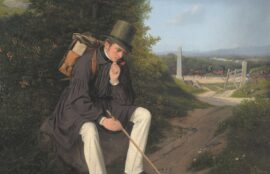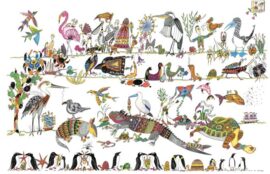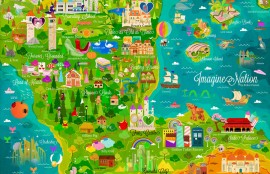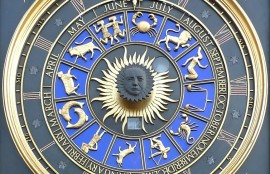
Two ideas feature at the core of all quest stories: these are the Abyss and the World Journey.
The Abyss is one of humanity’s oldest and most tenacious ideas that has been used for millennia to describe a place that is deep, inaccessible, extremely dangerous, and somehow at the core of understanding. In some ancient texts, it is synonymous with the deep ocean and is often portrayed as the sea in films today. But its broader meaning encompasses all the dark, deep places we go when we embark on an adventure to find answers. It’s where the obstacles lie and the challenges are found, often in the form of a beast or monster that must be overcome. The Abyss shapes the idea of what a challenge means.
The World Journey is a much newer term, adapted from Joseph Campbell’s Hero’s Journey. You may be familiar with the storyline, or plot, of the Hero’s Journey, as it was coined by the Sarah Lawrence College professor of literature in the twentieth century. In it, the hero goes through a sequence of experiences designed to help them face and overcome the many challenges of life, often in the context of a quest or adventure. Campbell presented a structure for this process, and it has become a reliable plot outline for the stages of character development in modern film and stories, such as J.R.R. Tolkein’s Lord of the Rings or George Lucas’s Star Wars. Campbell’s process leads toward self-actualization with deliberate stages that create a plot which leads a man (or sometimes a woman) through each step in specific order to experience certain hardships and, ultimately, achieve epiphany or personal growth.
The Abyss and the World Journey — where the heroes go and what they experience — embody the very nature of human change, though many stories can be overlooked as simple child’s play, especially in fairy tales. Heroic knights fighting dragons or a girl carrying a basket to her grandmother? Many could dismiss these as bedtime tales. But while these stories may seem soft, they likely began as images directed squarely at those about to experience a profound life change, such as puberty. These tales and their enchanting symbols have influenced not only our idea of what a hero’s adventure should be, but also of what success looks like and how personal achievement is earned.
Originally etched into stone slabs and scribbled on papyrus, many of these stories and children’s fairy tales have become Disney blockbusters, printed best-sellers, and on-screen hits. The symbol of the Abyss perennially renews itself, showing up at movie theaters every month with its deep-rooted ideas of descent and resurrection, and films inspired by the World Journey, such as Jurassic Park and Oh Brother, Where Art Thou? are enjoyed by people of all ages.
Why do they endure? Why are World Journey stories some of the most popular stories shared again and again in cultures around the world? Because we can relate to a situation where a person falls (or is pushed) into a terrifying cave and must survive. We understand what it means to find oneself in a frightening “wilderness” with no support, no skills, no training, no hand to hold. We’ve been there ourselves through adversities such as the loss of a loved one, by being orphaned, being the new kid at school, or failing in a business or relationship. Or as simply as missing a chance, forgetting an idea, or failing to live up to our own (or others’) expectations.
Today’s audiences love the same images that captivated people hundreds of years ago: water, darkness, dragons, beasts, labyrinths, forests, and caverns. These symbols endure because they don’t speak about money or politics. They don’t appeal to our wallets or even, in a direct sense, to our minds. Instead, they speak to our innermost fears and desires, to the obstacles we all face and the meaningful purpose we feel when we overcome them.
The story of a person who falls into the Abyss and is never seen again is not an inspiring story. It teaches nothing except to watch where you walk. But the story of a woman who braves the face of a lion to pluck its whisker, or of a desperate man who crosses the deep water in a small boat from the shore thousands of miles from his home, or of a scientist who plumbs the ocean’s depths in search of meaning and returns home as a much stronger person — that is an intriguing story and one that implies self-fulfillment and maturity.
In other words, Newton’s gravitational notion of “what goes up must come down” is not nearly as old or as relevant as “what goes down must come up.” Such a story inspires and motivates, and it even implies heroism, which is what most of these stories are mistaken for on the surface (and how Campbell named them). But the reason these stories have survived centuries, and in some cases millennia, is not because they celebrate heroism but because they teach that these traits of survival and fulfillment are attainable by everyone, even the most mortal of us. Even the silliest, poorest, most confused, and frightened of us can make changes in our lives to experience not only enlightenment but epiphany. Recognizing this when we have screens in every room, distractions at every turn, and challenges in every aspect of our lives is essential; the quest is not only for the hero, but it is for each of us.
The Value Of A Challenge
The ideas of adversity, hardship, and conflict are not concepts we are naturally drawn to. Parents and caregivers generally try to shield their children from hardship in an attempt to safeguard them from the hurtful obstacles of life and keep them safe. But the process of maturing means facing difficulties head-on rather than avoiding them. While it includes terrible adversity, the purpose of the World Journey is not to scare or punish us, but rather to support our growth, and to do that we must look in the face of that which frightens us the most.
Unfortunately, many of today’s stories of princesses and dragons are sugary and fluffy, diluted shades of what used to be quite powerful symbols. Modern adaptations of fairy tales would have us believe that success is easy — that if we only wish upon a star or wrinkle our noses our dreams will come true. The original versions, however, showed that change is far more difficult. Original fairy tales guide us down a darker path with frightening beasts and scary forests that no seeker truly wants to walk into.
And I would argue that while those original stories, especially those collected and recorded hundreds of years ago by Charles Perrault and the Grimm brothers, were indeed dark, frightening, and often overtly violent or callous, they should not be sugared over simply because they are scary, depressing, or harsh. They served a much needed purpose by symbolically painting a reality that most people experienced and still do experience in their lives: namely, challenging situations that push us to our limits and are, in fact, our very best opportunities for change and growth. Those storytellers and parents long ago knew that persistence allows us to become strong and resilient adults. That facing our fears can make us compassionate, forgiving, and joyful. That making difficult decisions instills in us a feeling of accomplishment and maturity. And, that experiences of confusion and uncertainty can open our minds to new ideas and creative expression that allow us as individuals, and as societies, to flourish.
 World Journey stories teach us to overcome adversity, but more importantly, they teach us how to experience adversity in the first place. Successful myths, religious texts, and fairy tales — and modern screenplay and film — do not skirt the issue of hardship and conflict, nor do they encourage us to finish the hard work as quickly as possible. The characters in J.K. Rowling’s Harry Potter do not face obstacles and beasts simply to advance the plot, but to develop the inner courage and tenacity needed to grow as individuals within society. Mythic stories put us squarely in the middle of the hardest tasks we can imagine, and they force us to work hard, to guess, to take leaps of faith, and to test ourselves to the limit.
World Journey stories teach us to overcome adversity, but more importantly, they teach us how to experience adversity in the first place. Successful myths, religious texts, and fairy tales — and modern screenplay and film — do not skirt the issue of hardship and conflict, nor do they encourage us to finish the hard work as quickly as possible. The characters in J.K. Rowling’s Harry Potter do not face obstacles and beasts simply to advance the plot, but to develop the inner courage and tenacity needed to grow as individuals within society. Mythic stories put us squarely in the middle of the hardest tasks we can imagine, and they force us to work hard, to guess, to take leaps of faith, and to test ourselves to the limit.
They also teach us that it’s worth it to “dive deep” and to experience a change so drastic that it is profound. In fact, though they seem superficial now in the age of animated princesses, the early stories of Little Red Riding Hood and Snow White are popular precisely because they show these challenges, as do the Bible story of Jonah and the Mesopotamian poem of Gilgamesh, which is perhaps the oldest story we’ve ever found. Written more than 4,000 years ago, Gilgamesh was an amazingly influential and well-loved character whose journey taught scores of generations of children the meaning of perseverance, curiosity, and spiritual growth. His tale depicts a hero in terribly dire circumstances who does not shrug off hardship but instead plows right through it, diving deep (literally and symbolically) to work through his fear of death. Only after completing difficult tasks and overcoming obstacles does he mature as a person. Of course, he fails to find immortality, but that’s the point.
It’s important to recognize that exploring and understanding these concepts is not only for the experts. In fact, it’s for every person to engage in these questions and to open their minds to the possibilities that exist within human nature and within the self, to explore stories and symbols and push into growth. Curiosity is what drives human transformation, and I invite us all to be curious. To be open and willing to see the metaphor in these stories as chances for personal growth is an opportunity for taking the symbols of storycraft and digging deeper into reflections of self-growth, core purpose, and even epiphany.
Original article here






















Sorry, the comment form is closed at this time.